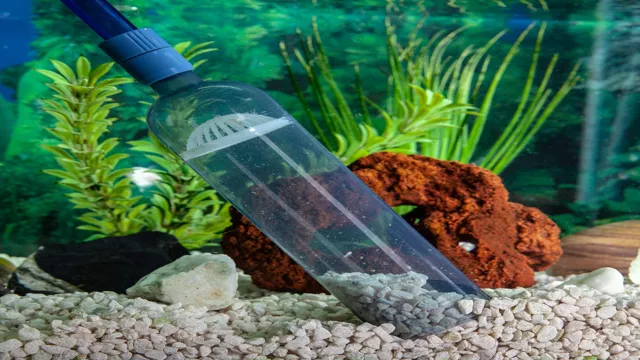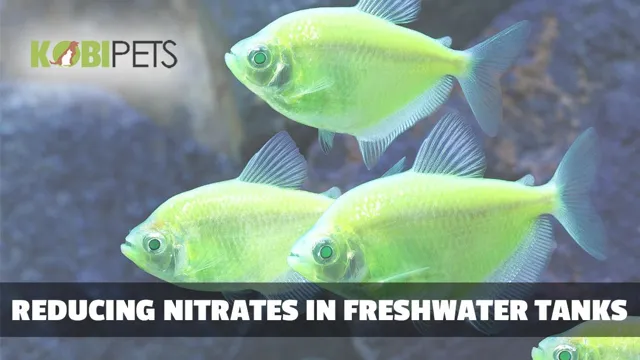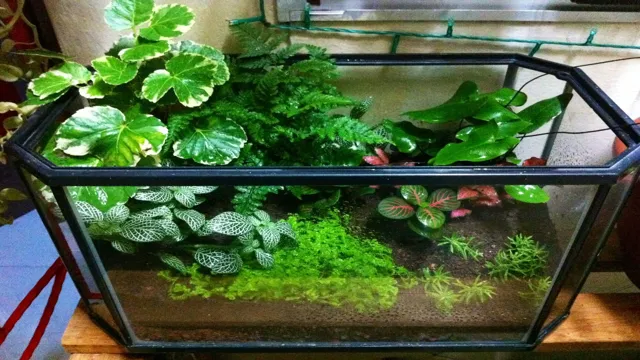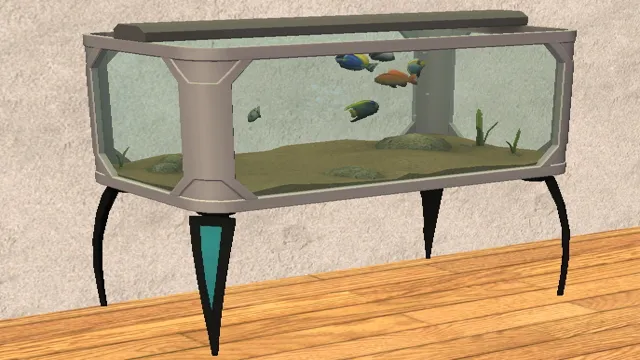Do you love having an aquarium, but detest having to clean it? We know the feeling! Aquariums are a beautiful and calming addition to any home, but they require constant maintenance to keep them clean and healthy for your fishy friends. One of the most important aspects of maintaining your aquarium is keeping the substrate clean, as it is where the majority of bacteria growth occurs. However, this can be a daunting task, especially if you have a lot of water in your tank.
Luckily, it is possible to clean your aquarium substrate with a low water level, making the process much simpler and less time-consuming. In this blog post, we will discuss the benefits of cleaning aquarium substrate with a low water level and provide you with tips on how to do it effectively. So, sit back, relax, and let’s dive into the wonderful world of aquarium substrate cleaning!
Preparing for the Substrate Cleaning
Cleaning your aquarium substrate with a low water level requires some preparation to ensure that you get the best results possible. You should start by familiarizing yourself with the substrate that you have and the cleaning solutions that you’ll be using. Ensure that you have all the tools you need, including a substrate cleaning tool, a bucket, and a siphon.
Clear any debris or plants that might be covering the surface of the substrate that you need to clean. Remove any fish in the tank and place them in a separate holding tank for the meantime. Once you have everything ready, start by draining enough water to expose the substrate that you need to clean.
Keeping the water level low will allow you to have a better view of the substrate and concentrate on areas that need cleaning. Cleaning your aquarium substrate with a low water level is necessary to maintain a healthy and conducive environment for your fish or aquatic animals.
Remove Fish and Plants
Preparing the aquarium for a substrate cleaning can be a complicated process, but it is necessary for maintaining a healthy and vibrant aquatic ecosystem. One of the first steps is to remove any fish or plants in the tank and transfer them to a temporary location. This not only ensures their safety during the cleaning process but also allows for easier access to the substrate.
It is important to handle fish with care, using a soft net and avoiding any sudden movements that may cause them distress. Likewise, plants should be gently uprooted and placed in a container with sufficient water to prevent drying out. With the fish and plants safely removed, the substrate cleaning process can begin, allowing for a clean and healthy home for aquatic life.
So, let’s ensure the safety of our fish and plants and prepare them for a fresh new home.
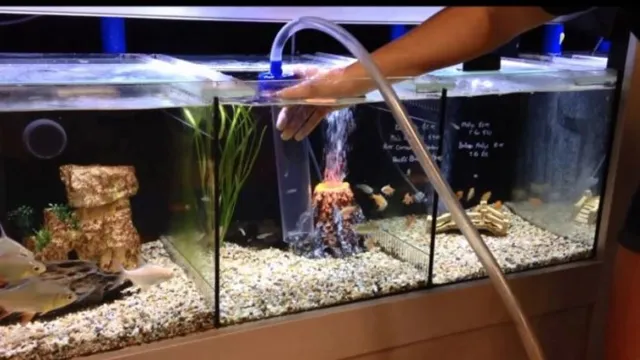
Drain Water to the Required Level
When it comes to cleaning your aquarium substrate, it’s important to take some preparatory steps before diving into the process. One of the first things you’ll want to do is drain the water to the required level. This will make it easier to remove any debris or build-up that has accumulated on the bottom of your tank.
The exact level of water you should drain will depend on the size of your aquarium and the type of substrate you have. A general rule of thumb is to lower the water level to about half of the tank’s height. This will allow you plenty of room to work while still leaving enough water in the tank to keep your fish and plants healthy. (See Also: How to Figure Amount of Fish for Aquarium: A Complete Guide for Beginners)
Once the water is drained to the appropriate level, you can begin the process of cleaning your substrate, removing any excess waste or debris that has accumulated over time. With a little bit of preparation and the right tools, you can keep your aquarium clean and healthy for your aquatic pets for years to come.
Cleaning the Substrate
Cleaning aquarium substrate can be a daunting task, especially when dealing with a low water level. However, it is an essential part of maintaining a healthy aquarium environment for your fish and plants. The first step is to remove any excess debris or waste from the substrate using a gravel vacuum.
This tool works by sucking up debris while leaving the substrate in place. Be sure to start at the lowest point of the aquarium and work your way up to avoid stirring up any settled debris. Next, use a algae scraper or brush to remove any algae growth on the substrate and glass walls.
Lastly, refill the aquarium with fresh, treated water, making sure to keep the water level consistent. It is important to not remove too much of the substrate in the cleaning process, as it can disrupt the natural balance of beneficial bacteria. By regularly cleaning your aquarium substrate, you can ensure a healthy and thriving aquatic environment for your pets.
Use a Gravel Vacuum or Siphon
One of the best ways to maintain a healthy aquarium is by cleaning the substrate and removing any debris that may have settled there. A gravel vacuum or siphon is a great tool for this job. This device allows you to easily remove debris from the bottom of the tank without having to remove all the water.
First, you’ll need to fill the vacuum with water from the tank. Then, place the vacuum over the substrate and start suctioning up any debris that you see. As you move along the bottom, be sure to remove any leftover food, dead plant matter, or waste from your fish.
By using a gravel vacuum or siphon regularly, you’ll keep your aquarium substrate clean and improve the overall health of your fish and plants. Remember to take your time and be gentle – you don’t want to suck up any of your fish or plants in the process!
Squeeze the Vacuum or Siphon to Remove Debris
When it comes to maintaining a healthy and thriving aquarium, keeping the substrate clean is crucial. A buildup of debris, uneaten food, and waste can not only harm your fish but also have a negative impact on the overall water quality. One way to clean the substrate is through the use of a vacuum or siphon.
These tools allow you to remove debris and waste that settle on the bottom of the tank, keeping your aquarium clean and your fish healthy. To use a vacuum or siphon, simply place one end into the water and create suction by either squeezing the vacuum bulb or using a gravity-fed siphon. Gently move the tool across the substrate, making sure to cover the entire area. (See Also: How to Control Snails in Aquarium and Keep Your Plants Safe)
You will see waste and debris being sucked up into the tube. Be careful not to over-clean the substrate too frequently, as this can disrupt the beneficial bacteria that naturally form in the tank. By incorporating regular substrate cleaning into your aquarium maintenance routine, you can ensure a happy and healthy aquatic environment for you and your fish.
Scrub the Substrate gently with a Soft Brush
When it comes to maintaining a healthy aquatic environment, cleaning the substrate is an essential aspect to consider. Over time, algae and other organic matter can accumulate on the floor of your aquarium, making it difficult for your fish and plants to thrive. To clean the substrate, start by gently scrubbing it with a soft brush.
Be careful not to apply too much pressure or you may damage the substrate. Slowly move the brush in circular motions over the surface of the substrate, working in small areas at a time. If there are any stubborn spots, try focusing on those areas with a bit more pressure, but be careful not to scratch the glass or acrylic surfaces of your aquarium.
Once you have finished scrubbing the substrate, be sure to use a siphon or aquarium vacuum to remove any debris or loose material that has been dislodged. By regularly cleaning your aquarium substrate with a soft brush, you can ensure that your aquatic friends have a healthy and happy home.
Refilling the Tank
When it comes to cleaning the substrate of your aquarium, doing it with low water levels can be a real challenge. But don’t worry, I’m here to help! The first thing you need to do is to drain the tank until the water level is low enough that you can reach the substrate easily. Then, using a siphon or a gravel vacuum, remove any debris that has built up on the substrate, being careful not to disrupt any plants or disturb the substrate too much.
Once you’ve removed all the debris, refill the tank with fresh water and add any necessary chemicals or supplements to maintain a healthy environment for your fish. With a little bit of patience and effort, you can keep your aquarium clean and your fish happy and healthy. Remember, a healthy tank is a happy tank!
Add Dechlorinated Water Slowly
When it’s time to refill your fish tank, one important thing to keep in mind is to add dechlorinated water slowly. This is because fish are very sensitive to changes in their environment, and sudden shifts in water chemistry can be highly stressful for them. In fact, rapid changes in water temperature or pH levels can even be fatal for your fish.
To avoid this, take your time when refilling the tank. Begin by adding small amounts of dechlorinated water at a time, and wait a few minutes in between each addition. This will give your fish time to acclimate to the new water and adjust to any changes in chemistry.
In addition to keeping your fish safe and healthy, adding water slowly also helps to reduce the chance of cloudy water or algae growth. When you pour in water too quickly, it can cause debris and sediment to become dislodged, creating a cloudy and unsightly appearance in your tank. Taking your time and adding water gradually can help keep things looking clear and clean. (See Also: How to Clean Out Aquarium Water Change Hose: Tips and Tricks)
Overall, refilling your tank can be a great opportunity to give your fish a fresh and healthy environment to thrive in. Just remember to take it slow, add dechlorinated water gradually, and give your fish time to adjust to their new surroundings. With a little bit of care and attention, your tank can provide a beautiful and tranquil home for your aquatic pets!
Test the Water Parameters
Now that you’ve successfully drained and cleaned your tank, it’s time to refill it with fresh water. But before you do, it’s important to test the water parameters to ensure that everything is balanced and safe for your fish. This is especially important if you’re using tap water because it can contain chlorine and heavy metals that can harm your aquatic pets.
You can use a water testing kit to determine the levels of ammonia, nitrate, nitrite, pH, and water hardness. Once you know the levels, you can add any necessary water conditioners to ensure that the water is safe for your fish. It’s also a good idea to let the water sit for a few hours to allow the temperature to stabilize and the chemicals to dissipate before reintroducing your fish.
By testing the water parameters, you’re ensuring the health and well-being of your aquatic pets, making it a crucial step in the refilling process.
Conclusion
Cleaning aquarium substrate with a low water level may seem like a daunting task, but with a bit of ingenuity and elbow grease, you can be swimming in success. Follow these simple steps to ensure a healthy and happy aquatic environment for your fishy friends. And always remember, a clean tank is a happy tank, so don’t let the muck get the best of you!”
FAQs
Question 1: What are the benefits of cleaning aquarium substrate with a low water level? Answer: Cleaning aquarium substrate with a low water level provides better access to the substrate and makes it easier to remove any debris or waste. It also helps to prevent disturbing the fish while cleaning. Question 2: What tools should be used to clean aquarium substrate with low water level? Answer: Tools such as a siphon, gravel vacuum, and aquarium scraper can be used to clean the aquarium substrate with low water level. Question 3: Should I remove the fish while cleaning the aquarium substrate with low water level? Answer: It is recommended to remove the fish from the aquarium while cleaning the substrate. This helps to prevent any stress or harm to the fish. Question 4: How often should I clean the aquarium substrate with low water level? Answer: It is recommended to clean the aquarium substrate with low water level at least once a month. However, the frequency of cleaning may vary depending on the number of fish in the aquarium and the size of the tank. Question 5: Can I use soap or detergent to clean the aquarium substrate with low water level? Answer: No, it is not recommended to use soap or detergent to clean the aquarium substrate with low water level as it can harm the fish. Question 6: What steps should be followed to clean the aquarium substrate with low water level? Answer: The steps to clean the aquarium substrate with low water level include removing the fish from the tank, draining the water to a safe level, using a siphon or gravel vacuum to remove debris, and rinsing the substrate before refilling the tank. Question 7: Is it necessary to clean the aquarium substrate with low water level? Answer: Yes, it is necessary to clean the aquarium substrate with low water level as it helps to maintain the overall health and cleanliness of the aquarium environment.

